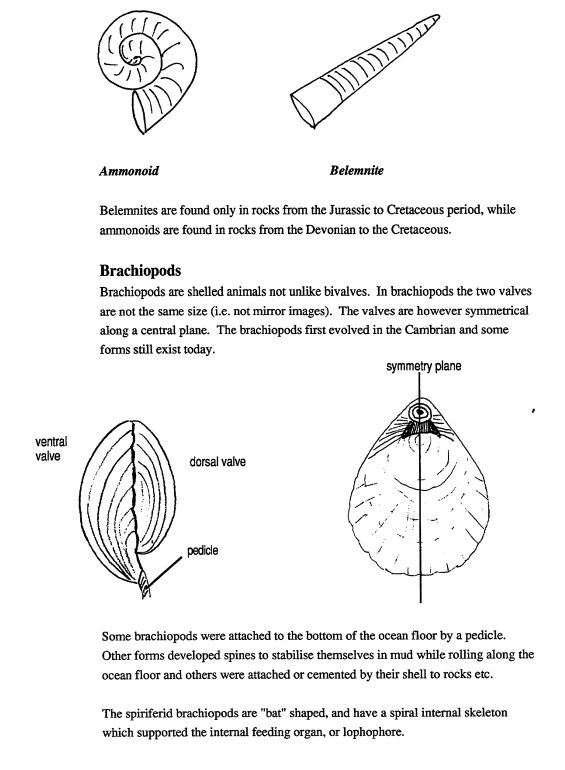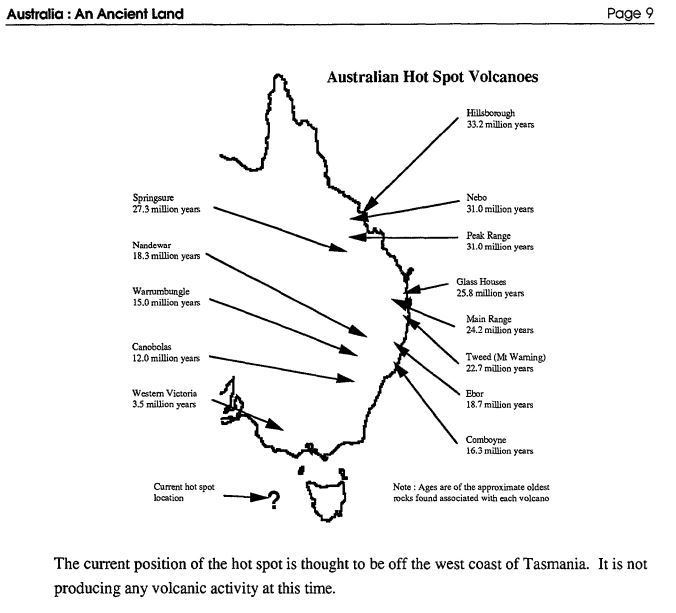fossil
Type of resources
Keywords
Publication year
Topics
-
Early Middle Cambrian faunas from the Jigaimara Formation from Elcho, Howard and Banyan Islands in the Arafura Basin, Northern Territory are analysed. They include the species: Pagetia hainesi sp. nov., P. aff. edura Jell, P. sp. indet., Xystridura templetonensis (Chapman), X. remorata Opik, X. ?filifera Opik, X. sp. indet., ptychoparioid sp. 1, ptychoparioid sp. 2, Oryctocephalites ?reynoldsi (Reed), Arthricocephalus sp. nov. and ?Itagnostus sp.. All indicate an age of early Templetonian (i.e. predating T. gibbus), and indicate a close similarity with the fauna of the Beetle Creek Formation of western Queensland
-
This black and white education resource is a 58 page booklet which contains information on geological time, fossilisation, characteristics of major groups of vertebrate and invertebrates, micropaleontology (e.g.. spores and pollen), trace fossils and the uses of fossils. It includes student activities. Suitable for secondary Years 7-10
-
This Fossils booklet will take you through concepts of geological time and fossilisation. It also provides fact sheets on important animals and plants in the fossil record. Each fact sheet contains a description of the organism to aid in identification, information on when, where and how the organism lived as well as interesting facts to grab your students' attention. Students activities are also included.
-
The warm greenhouse world of the Late Cretaceous created an ocean that was poorly stratified latitudinally and vertically. Periodically these oceans experienced globally significant events where oxygen minimum zones enveloped the continental margins. Evidence of the effect of one of these Ocean Anoxic Events (OAE?s) is preserved in the southern high latitude strata of the Otway Basin in southeast Australia. During the Late Cretaceous, thick sequences of mudstone-dominated deltaic sediments (the Otway Delta) were deposited in an elongate inlet (ca. 500km wide) between Antarctica and Australia located at least 70?S. The initial Turonian strata of this delta (the Waarre Formation) were deposited in marginal marine delta plain to delta front conditions. The overlying Flaxman Formation and basal Belfast Mudstone preserve evidence of transgressive inner to middle shelf upper delta to prodelta conditions. These Turonian units were subject to periodic dysoxia. The conditions that created this dysoxia in the region were similar to those of the high northern latitude Cretaceous Interior Seaway of North America where intermittent freshwater input and deepening seas caused periods of thermohaline stratification and reduced bottom waters. The overlying Coniacian to Santonian Belfast Mudstone was deposited in outer shelf to upper slope prodelta conditions subject to periodic fluctuations in dysoxia with normal marine salinities. After a period when the oxygen minimum zone contracted, upward-increasing dysoxia in the Belfast Mudstone herald the onset of the Coniacian to Santonian OAE 3. This was the last OAE of the Late Cretaceous, prior to the onset of more ?modern? oceanic conditions. The fluctuations in TOC and hydrogen index in these strata reflect variable dysoxic conditions similar to that reported for OAE 3 in the tropical eastern Atlantic by Hofmann et al. (2003). This periodicity implies a very active and dynamic Late Cretaceous hydrosphere. Eventually, hyposaline conditions or higher sedimentation rates due to upper delta progradation and shallowing in the Santonian caused the local extinction and dissolution of many of the calcareous benthic taxa of the Belfast Mudstone.
-
This black and white resource is an 18 page booklet including geological time, rock clocks, the age of famous Australian places, Australia on the move, Australian volcanoes, Ice Ages, Ancient Australian life, how fossils form and some common Australian fossils. Includes student activities suitable for primary Years K-6.
-
This black and white 64 page education resource examines the dynamic nature of Earth's climate (past and present) and its many influencing factors. Includes student activities. Suitable for secondary Years 7-12.
-
This set of four charts provide an update of the million year numbers assigned to Australian palynological zone boundaries to the latest Geologic Time Scale 2004, authored by Gradstein et al. (2004), over the geological time interval Jurassic to Recent. These charts have been drafted to help display the relationships of the palynological zones to the new timescale and to assist in scaling the zones and subzones, so that most million year ages assigned to the zone boundaries are mostly numbers with not more than one decimal place.
-
Poster about the Woolshed Creek fossil site discovered by W.B. Clarke in 1844 now being rehabilitated as a geological heritage site, after Madura Parkway roadworks.
-
This set consists of 15 slides and explanatory text detailing the nature of dinosaur fossils from Southern Australia, as determined by scientists working along Australia's southeast coast. Find out about the dinosaurs that lived at polar latitudes between 120 to 110 million years ago and the fascinating methods they developed to cope with the climate of that region. The images include actual fossils discovered and reconstructions of dinosaurs and the plants and animals with which these dinosaurs were associated. Also available on CD-ROM (catalogue item 39797) Suitable for primary Years 5-6 and secondary Years 7-12.
-
This document is a professional opinion, presenting an assessment of the macrofossils present in well CKAD0001, located in the Northern Territory in the Georgina Basin.


